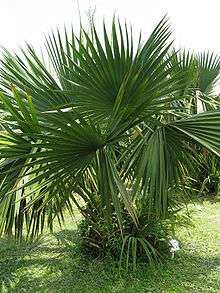Sabal minor
| Sabal minor | |
|---|---|
 | |
| Scientific classification | |
| Kingdom: | Plantae |
| Clade: | Angiosperms |
| Clade: | Monocots |
| Clade: | Commelinids |
| Order: | Arecales |
| Family: | Arecaceae |
| Genus: | Sabal |
| Species: | S. minor |
| Binomial name | |
| Sabal minor (Jacq.) Pers. | |
| Synonyms[1] | |
|
Synonymy
| |
Sabal minor, commonly known as the dwarf palmetto,[2] is a small species of palm. It is native to the deep southeastern and south-central United States and northeastern Mexico. It is naturally found in a diversity of habitats, including maritime forests, swamps, floodplains, and occasionally on drier sites.[3] It is often found growing in calcareous marl soil.[4] Sabal minor is one of the most frost and cold tolerant among North American palms.
Distribution
This palm's native range spans on the Atlantic Coast from central Florida north to Monkey Island, North Carolina. On the Gulf Coast, it spans from central Florida to central Texas, Arkansas, north to southern Oklahoma and south in the State of Nuevo León in Mexico.[1] It was perhaps historically present in southeastern Virginia,[5] although this is not considered to be part of its natural range by leading authorities.[4]
Description
The dwarf palmetto grows up to 1 m (rarely 3 m) in height, with a trunk up to 30 cm diameter. It is a fan palm (Arecaceae tribe Corypheae), with the leaves with a bare petiole terminating in a rounded fan of numerous leaflets. Each leaf is 1.5–2 m long, with 40 leaflets up to 80 cm long, conjoined over half of this length. The flowers are yellowish-white, 5 mm across, produced in large compound panicles up to 2 m long, extending out beyond the leaves. The fruit is a black drupe 1–1.3 cm long containing a single seed.[3]
Cultivation
Sabal minor is one of the most cold hardy palms, second only to the needle palm, Rhapidophyllum hystrix. It is leaf hardy to near 0 F/-18 C, and has been known to survive brief periods of -5 F temperatures. In the United States, large healthy specimens have also been growing since the 1960s in areas like Central Tennessee, Washington, DC (National Botanical garden), and in the lower Ohio Valley. Sabal minor is cultivated in small numbers in mild coastal areas as far north as coastal Connecticut/Long Island, New York on the East Coast, and Vancouver BC on the West Coast. It is a recommended horticultural plant by the Virginia Cooperative Extension.[6] There are several cultivars, including those from the Outer Banks of North Carolina (northernmost strains), and those from Oklahoma and Texas. One popular strain is 'McCurtain', named after McCurtain County, Oklahoma where they are native. These tend to remain trunkless and smaller than those from warmer areas. Sabal minor is a popular landscape palm in coastal resort areas from Virginia Beach, VA to southern Texas.
Gallery
 Young Sabal minor
Young Sabal minor
References
- 1 2 Kew World Checklist of Selected Plant Families
- ↑ "Sabal minor". Natural Resources Conservation Service PLANTS Database. USDA. Retrieved 26 October 2015.
- 1 2 Sabal minor in Flora of North America
- 1 2 "Flora of the Southern and Mid-Atlantic States by Alan Weakley".
- ↑ Studies on the Geography of Virginia
- ↑ Care Sheet for Sabal minor or “Dwarf Palmetto” in Virginia Landscapes Fact and Care Sheet for Virginia Gardens